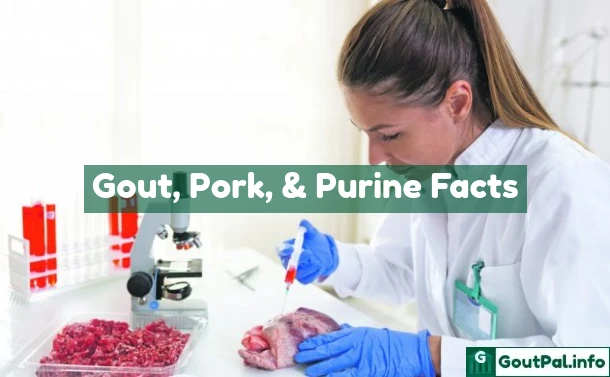Gout & Pork Research
Worried if pork is good or bad for gout? Get the porky, gouty, facts here.

Gout sufferers are concerned about their pork consumption. So they need to learn about factors of pork production that can affect uric acid and gout.
Gout & Pork Research Topics
Here are five studies that cover most aspects of the links between pork and gout.
Pork & Gout Patient Triggers
The aim of my first study is to identify gout patient's knowledge about their condition and how to manage it. Finding that the majority of gout patients failed to recognize 5 out of 6 common gout triggers. With the worst result of only 7% recognizing pork as a gout trigger.
Harrold, L.R., Mazor, K.M., Peterson, D., Naz, N., Firneno, C. and Yood, R.A., 2012. Patients’ knowledge and beliefs concerning gout and its treatment: a population based study. BMC Musculoskeletal Disorders, 13(1), pp.1-8.
Specifically, more patients incorrectly reported vegetables (58%), chicken (55%) and legumes (39%) as triggers as compared to foods documented to cause gout flares including seafood (23%), beef (22%) and pork (7%).
Pork Purines
The aim of my second study was to identify purine content in different cuts of pork and beef. Finding that pork rump had the highest total purine level (1,507 mg/kg). Followed by pork tenderloin (1,448 mg/kg) and fore hock (1,294 mg/kg). With the lowest purine pork being loin chop (1,129 mg/kg).
Rong, S., Zou, L., Zhang, Y., Zhang, G., Li, X., Li, M., Yang, F., Li, C., He, Y., Guan, H. and Guo, Y., 2015. Determination of purine contents in different parts of pork and beef by high performance liquid chromatography. Food chemistry, 170, pp.303-307.
As pork and beef were purine-rich, we suggest that excess consumption be avoided, and pork loin chop and beef rib eye were more suitable for a low-purine diet relatively.
Breed & Quality Affect Pork Purines
My third study aimed to identify low purine pig breeds. Also, other factors that might influence lower purine pork products. Finding that breed and meat quality affect purine content.
More cuts of meat were measured compared to the previous study. Resulting in the following total purines. Arranged in decreasing order of mg/kg: lung (2,448), liver (2,262), kidney (2,026), semimembranosus muscle (1,374), large intestine (1,382), longissimus lumborum muscle (1,405), masseter muscle (1,331), heart (1,261), stomach (1,172), trotters (281), skin (266), and back fat (70).
Zheng, Min, Yizhong Huang, Jiuxiu Ji, Shijun Xiao, Junwu Ma, and Lusheng Huang. "Effects of breeds, tissues and genders on purine contents in pork and the relationships between purine content and other meat quality traits." Meat science 143 (2018): 81-86.
There was a great variation in purine contents in the twelve different porcine organs, which may be related to their function and cell composition. The purine contents were significantly correlated with meat quality, as meat with lower purine content showed higher pH, a bright redness and rich marbling. The results of this study not only provide the material of low purine pig breeding, but also indicate the enhancement of meat quality by purine content selection.
Pork Linked with Higher Uric Acid
The aim of my final study is to identify statistical links between eating certain foods with uric acid levels. It concludes that pork is one of seven foods linked with higher uric acid.
Major, T.J., Topless, R.K., Dalbeth, N. and Merriman, T.R., 2018. Evaluation of the diet wide contribution to serum urate levels: meta-analysis of population based cohorts. Bmj, 363.
Seven food items were associated with raised serum urate levels (beer, liquor, wine, potato, poultry, soft drink, and meat (beef, pork, or lamb)) and eight were associated with lower serum urate levels (eggs, peanuts, cold cereal, skim milk, cheese, brown bread, margarine, and non-citrus fruit)
Tasty Pork Purines
My final study aims to evaluate links between different pork purines and meat tastiness. Providing the food industry with new parameters for lower purine pork products while maintaining flavor.
Huang, C., Zheng, M., Huang, Y., Liu, X., Zhong, L., Ji, J., Zhou, L., Zeng, Q., Ma, J. and Huang, L., 2021. The effect of purine content on sensory quality of pork. Meat Science, 172, p.108346.
manipulation of different purine levels is a potential means of improving sensory quality, including: 1) reducing the contents of hypoxanthine and adenine, thereby reducing the total purine content in meat and improving tenderness and juiciness; 2) properly increasing the content of guanine (or GMP) to improve the umami taste. Therefore, this study provides a reference for adjusting purine content in pork by using nutrition and breeding techniques in the future.

Pork & Your Gout Story
Which aspects of gout and pork are you interested in? How do you think eating pork might help or hinder your gout?
Please tell me your gout and pork story in the Gout Forum.
Be aware that you can customize GoutPal pages to add your own facts and concerns. Click any highlight, such as 'gout and pork' to learn more.
Leave Gout & Pork Research to browse the Gout and Uric Acid Science Blog.
